Over the past year, Google has implemented several major updates to Business Profile (formerly Google My Business). And while no public announcements have been made as to the overarching purpose of these changes, we believe that they may be connected, potentially laying the foundation for Google to monetise GBP profiles.
In this blog post, we explore these developments, the potential shift to a subscription-based GBP, and what it could mean for your business.
Why we care about the future of Google Business Profile
Google Business Profile (GBP) is an incredibly powerful and underappreciated tool for businesses with a local focus. At TDMP, we've seen firsthand how optimising these profiles can transform local search outcomes and drive highly engaged traffic to client websites.
As we discuss later in this post, local search is quickly gaining prominance, meaning creating and maintatining a Google Business Profile will only become more essential for local SEO as the months go by. Yet, a subscription fee would be porhibitive for many business owners, and those who do have the budget may choose not to invest — ultimately leading to a mighty shake-up of local search rankings.
We can’t be certain of Google’s exact plans, but recent GBP updates seem to signal that Google might be preparing to transition GBP profiles into a paid service in the near future, effectively making them an advanced form of paid ad.
A disclaimer
Before we begin, note that this exploration is speculative.
While some of the signals we’ve been observing hint that Google could be planning to monetise GBP profiles, as of yet — there is no hard evidence. However, we at TDMP feel it’s important to forewarn our clients and the greater digital marketing community of important possibilities.
Why we think Google might monetise GBP
The 2019 survey
In April 2019, Google sent surveys to select business owners. These surveys presented several potential paid Google Business Profile features, as seen in the screen grabs below.
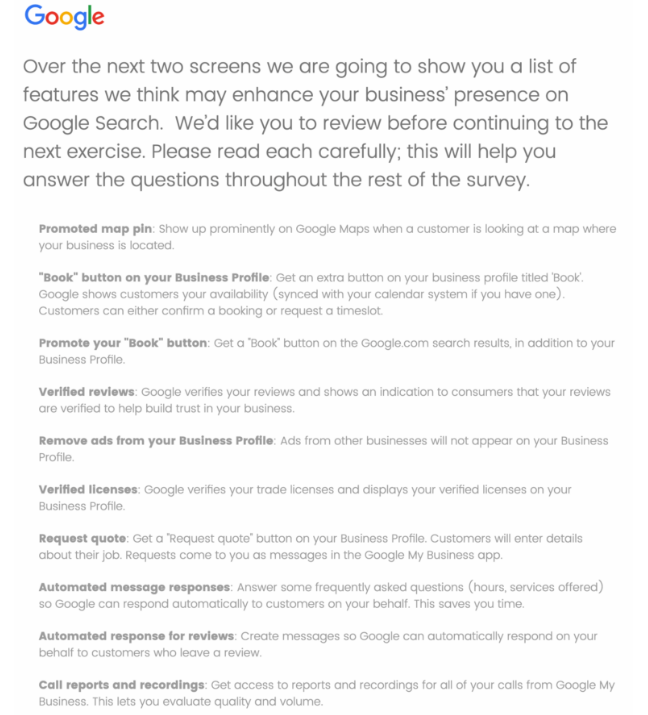
Source: Search Engine Land
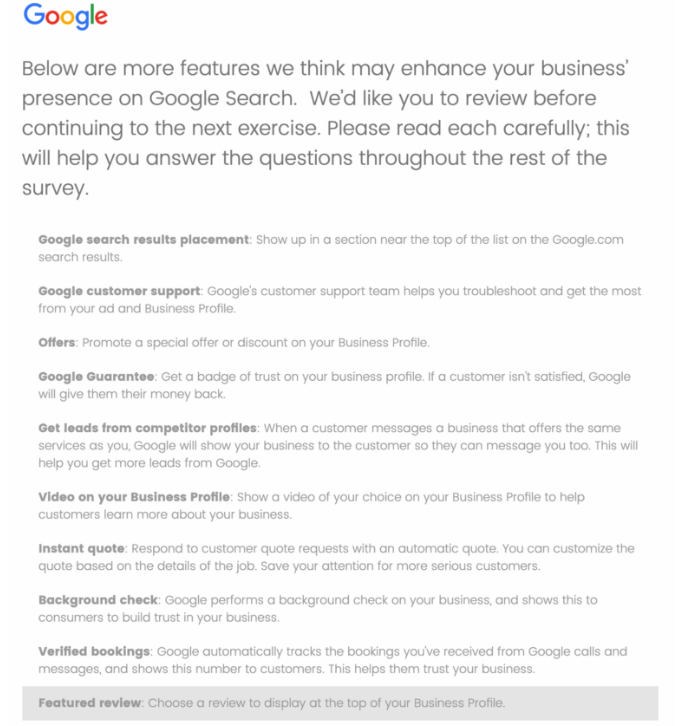
Source: Search Engine Land
On the next page of the survey, respondents were asked to state their preference between four different feature bundles. Once selected, the respondents were presented with the monthly subscription fees of each bundle and asked to select again based on the pricing information.
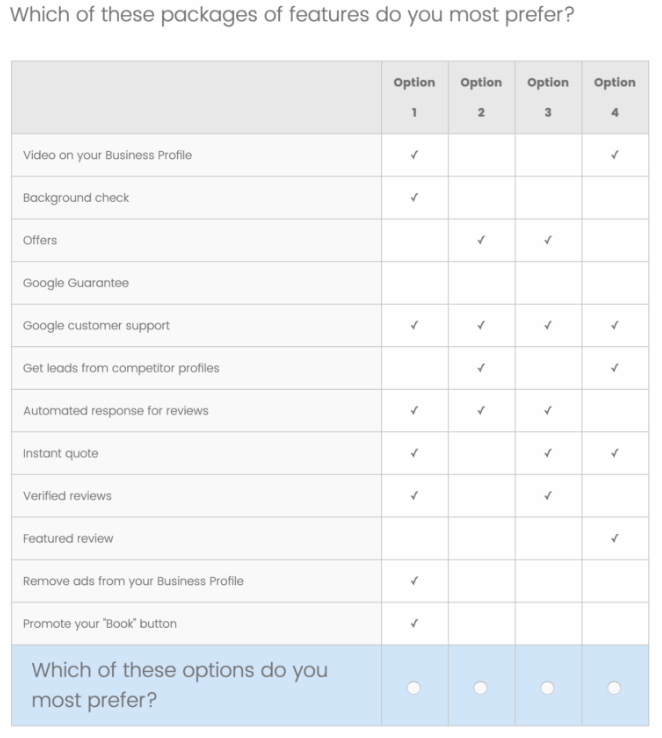
Source: Search Engine Land
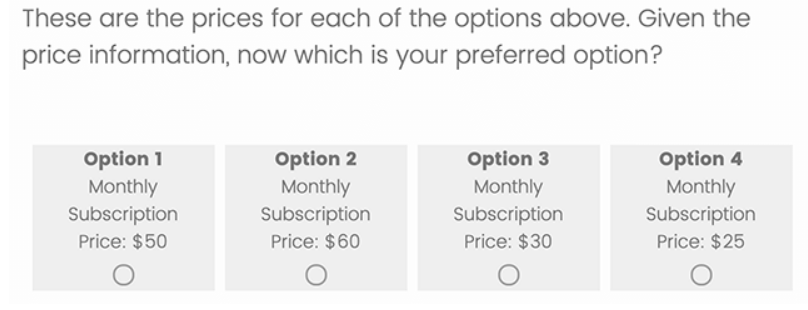
Source: Search Engine Land
Finally, the survey asked if respondents would realistically purchase their preferred feature package:
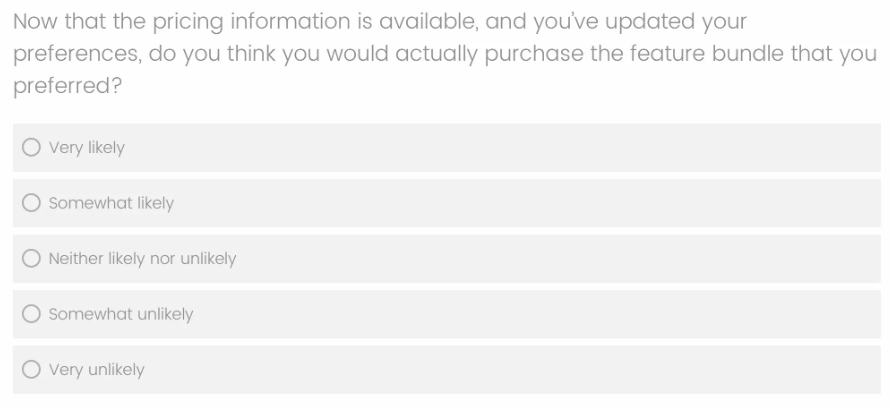
Source: Search Engine Land
As you may have noticed, some of the proposed features in this 2019 survey - including “Verified Licences”, “Background Checks”, “Google Guarantee”, and “Promoted Map Pin” - were already or have since been implemented in some form as free GBP features. This could have been an attempt to shore up some weak spots (namely, spam profiles) in Google Business Profile in order to increase its value, making it more enticing prospect when it becomes a paid service.
While they haven’t made a peep about paid GBP features (the ones listed above or otherwise) since sending this survey, it shows us that Google has been seriously considering the viability of monetising business profiles for a while — and we feel the other shoe may be about to drop.
It would make commercial sense for Google to monetise Google Business Profile
We’ve known for a while that Google is hoping to increase monetisation on its search platform, and as GBP becomes more integrated in Google’s AI Overviews, now more than ever, it certainly makes commercial sense to put a price tag on GBP.
Here’s why.
The increasing importance of local search
As discussed in our previous post about the future of SEO, 46% of all Google searches have a local intent, meaning they request information about local businesses, services, or locations. As we move into the age of generative search, local intent stands to become even more prevalent, and we forecast that optimising for local will play a major role in boosting visibility in AI responses such as Google’s AI Overviews.
What’s more, averaging 80% (from mobile), local has the highest conversion rate of all search intents, and GBP bridges the gap between businesses and these likely-to-convert prospects. So, it’s easy to see why Google may want to eventually take a cut of the revenue for the business it is currently brokering for free.
Google Business Profile has become an essential aspect of local SEO
Google Business Profile has come a long way (and through 5 rebrands!) since launching in 2005. It wasn't always an essential tool, but Google's determination to continually define and improve GBP has paid off.
According to research from BrightLocal, 62% of consumers use GBP (in search results) to find a local business’ phone number or address — 13% more than the number of consumers that seek information from business websites. What’s more, verified Google Business Profiles generate, on average, around 200 clicks/interactions per month, highlighting the crucial role of the service in driving engagement.
Google has nurtured this steady upward trajectory by investing significant resources in Google Business Profile, adding new features and increasing profile visibility across the Google Search ecosystem. Consequently, GBP is now vital for local SEO, giving Google the leverage required to effectively transition the service to a subscription plan.
It would solve ongoing spam issues
While verifications and updates to machine learning algorithms have made a slight dent in Google Business Profile’s spam problem, the issue remains unresolved. In fact, spam alone poses the biggest threat to the reputation, trustworthiness, and authoritativeness Google has established in GBP through the years — and making it a subscription service might be a solution.
There are a few ways introducing GBP fees could drastically reduce the amount of spam on the service:
- Cost as a deterrent - Introducing a financial barrier makes it less attractive for spammers to create multiple fake profiles, as the cost of maintaining them would be prohibitive.
- Reinvestment - Subscription fees could fund initiatives to actively reduce GBP spam. For example, Google could assemble a dedicated team to manually review and approve new listings.
- Stricter validation processes - A subscription model could include more rigorous verification and validation processes. Businesses would need to provide more detailed documentation and undergo stricter checks to prove their legitimacy before their profiles are activated.
It’s fair to say that Google hasn’t been doing all it possibly can to reduce GBP spam, and the reason for their procrastination could well be that they’ve had plans to use a “pay-to-play” model as a fix and have been waiting for the perfect moment to set the transition in motion.
There was already some market viability years ago
When the Google survey first hit the inboxes of a handful of businesses, BrightLocal carried out their own survey, asking business owners if they’d actually consider paying for premium GBP features.
While the majority of respondents reported that they found the notion of paying for their business profiles “worrying”, the survey also showed that there was some market viability for certain benefits, such as higher SERP placement, removal of competitor ads, and pinned “feature” reviews at the top of listings.
Recent GBP updates
There have been three key changes we believe signal Google could soon cash in on our business profiles. Our reasoning? Each of these updates stripped a little bit of flexibility from the service.
Applying restrictions to a free service is a classic commercial move when preparing a monetisation strategy. The goal is to devalue the product in its free form in order to create demand for an advanced version that people would willingly pay for.
Let’s take a look at the changes we’ve been observing.
Changes in impression reporting
In February 2023, Google made a significant change to how it reports impressions for GBPs. Previously, businesses could see multiple impressions per user based on page appearances. Now, Google counts only one impression per user per 24 hours — and only if they actually click through to your GBP profile.
The value lost:
In a way, this new metric (named “unique user views”) is helpful, giving business owners an idea of the reach of their profile on a per-user basis, with more focus placed on actual daily engagement than simply appearing for a search. However, the absence of the original metric can lead to:
- Under-representation of engagement - If a user visits a business’s GBP multiple times in a day without clicking through, it still indicates a strong interest or intent to interact with the business. By only counting clicks, businesses might miss out on understanding the full extent of user engagement.
- Less insight into results of SEO efforts - Local SEO strategies often involve optimising GBP to appear in multiple searches throughout the day. With the new reporting method, businesses might not see the full impact of their SEO efforts, as the visibility in search results won’t be fully reflected in the impression count unless users click through.
- Challenges in measuring incremental changes - Small, incremental changes to a GBP, such as updating information or adding photos, might not show immediate impact on click-through rates.
- Limited insight into user behaviour - Understanding how often users are exposed to a GBP without clicking can provide valuable insights into user behaviour and preferences. For example, high impressions but low click-through rates might indicate that the GBP needs better optimisation or more compelling content. The new reporting method reduces the granularity of this insight.
- Difficulty benchmarking - Businesses often benchmark their performance against industry standards or competitors. With the change in reporting, it becomes challenging to compare current data with historical data or industry norms that were based on the previous reporting method.
Review display & visibility rankings update
In an attempt to boost the authenticity of reviews and present more valuable, unbiased information to users, Google removed first-party reviews as having any influence over business profile visibility.
The value lost:
While it’s true that this update will make sourcing third-party reviews more of a focus, resulting in more impartial representations of organisations using GBP, it carries several potential drawbacks for business owners:
- Inconsistent review quality - Third-party review platforms can vary widely in terms of review quality and reliability. Some platforms might have less stringent verification processes, leading to the possibility of fake or biased reviews influencing a business's GBP.
- Increased dependence on external platforms - Businesses must now focus on maintaining their reputation across multiple third-party review platforms.
- Potential system bias of external reviews - Third-party review platforms may have their own biases or algorithms that influence which reviews are displayed prominently. Businesses have no control over these external factors, which can impact the perceived reputation of their business.
Local ads and proximity targeting
Shortly after the March 2024 core algorithm update, Google updated how LSAs (Local Services Ads) rank in GBP profiles.
Previously, LSAs were heavily reliant on proximity targeting as a ranking factor, meaning ads were shown based on the user’s geographical closeness to the business in the ad. The new update removes this signal, and instead places emphasis on the service area of a business to determine relevance to a search.
The value lost:
Considering Google Business Profiles are highly tuned to proximity and are heavily reliant on location relevance, Google’s removal of proximity as a ranking factor for local services may mean that GBP listings no longer rank well organically — so there’s your lost value.
But this update is different to the others in that it directly undermines Google Business Profile as a concept. It is a problem that Google has willingly introduced, and a reason they might feel comfortable doing so is that they already have the solution… converting GBP profiles to paid ads.
By making this transition, local businesses can still gain prominent visibility, even if proximity is de-emphasised for organic rankings.
What this means for you
While we haven’t seen any evidence of profile engagement slipping yet, if Google does have plans to monetise GBP, the gradual degradation of the free service in favour of the paid service will take its toll.
While not everyone may want or be able to pay subscription fees, those who do invest will likely dominate local search, enjoying increased visibility and control over their online presence.
But we’re not there yet!
Thankfully, right now, Google Business Profile is a free service, and we recommend using it to your advantage while its still widely available. Through optimising business profiles, we’ve helped clients make huge strides in local search, significantly enhancing customer engagement and brand awareness – and we can do the same for you.
Contact TDMP today for expert local SEO support.
Final thoughts
We’ll bring this post to a close with another reminder that, until something concrete shows Google will be monetising GBP, this is all just speculation. But in digital marketing, being aware of the possibilities and getting ahead of the big changes is essential to the shaping and implementation of your campaigns.
Whether they support or refute our theory, we will update this post with any developments on the topic, providing conclusive answers as soon as they’re available.

